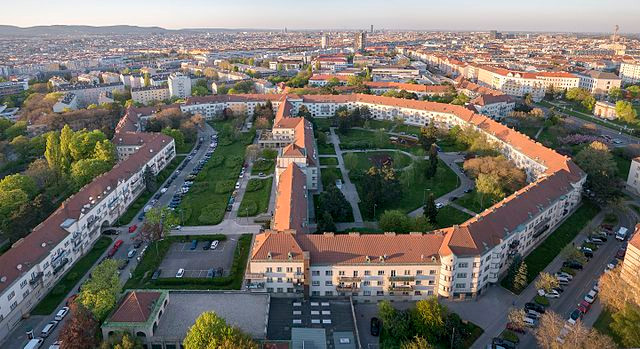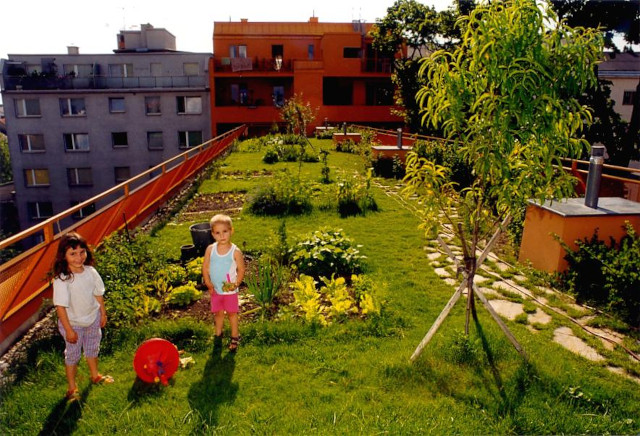
As a homebuilder for nearly 20 years, I concentrated on building affordable homes. Today it is almost impossible to do so. Whether it be restrictive zoning laws and building codes, higher interest rates, and competition by hedge funds for single-family housing units, families are being priced out. This will not end well.
During a global housing crisis, with soaring rents and an ever-widening gap between the haves and have-nots, it's worth examining alternative approaches to housing that prioritize affordability, stability, and community. One such model can be found in Vienna, Austria, where social housing has been a fundamental aspect of the city's fabric for over a century.
By studying Vienna's successful housing system, we can gain insights into how to address the pressing housing challenges faced by many societies, including the United States.
A Vision of Affordable Housing
Vienna's social housing program, Gemeindebau, was born from the city's progressive movement in the early 20th century. It aimed to provide affordable, high-quality housing for all residents, regardless of income or background. The result is a city where over 60% of the population lives in subsidized housing, enjoying the benefits of secure tenancy, reasonable rents, and well-designed living spaces.
Unlike the often stigmatized public housing projects in some countries, Vienna's social housing developments are known for their architectural beauty and integration into the urban fabric. The Gemeindebauten, or community buildings, are well-planned, aesthetically pleasing complexes that blend seamlessly with the surrounding neighborhoods.
Lessons from History
The roots of Vienna's social housing success can be traced back to the aftermath of World War I when the city faced a severe housing shortage. The visionary leaders of the time recognized the urgent need for affordable housing and set out to create a comprehensive system that would benefit the entire population. This commitment to social housing continued through the economic hardships of the Great Depression and the challenges of rebuilding after World War II.
In contrast, the United States also faced a housing crisis during the Great Depression, leading to the creation of government programs like the Home Owners' Loan Corporation and the Federal Public Works Administration. While these initiatives provided temporary relief, they ultimately prioritized homeownership and left a gap in addressing the long-term needs of low-income individuals and families.
In the US, the subsequent National Housing Act of 1934 perpetuated racial disparities through redlining policies, further deepening inequalities in access to housing and wealth accumulation. The focus on homeownership to build wealth disproportionately benefited those already well-positioned economically while neglecting the most vulnerable populations.
Vienna's Sustainable Approach
Vienna's social housing success lies in its sustainable and self-sufficient model. The city prioritizes affordable housing by reducing land prices through rezoning and rent control. Limited-profit housing associations play a crucial role in Vienna's housing system, constructing and managing affordable housing units. These associations are restricted to charging rents that reflect costs, and any surplus funds must be reinvested in the construction of new social housing, creating a revolving flow of financing.
This approach ensures long-term affordability and fosters community and social cohesion. Vienna's social housing complexes are designed with shared spaces, communal facilities, and amenities that promote interaction and a sense of belonging. This sense of community has been instrumental in creating a stable and inclusive environment for residents.

Sargfabrik, an award-winning social housing project, is the biggest self-governing community in Vienna, Austria. Photo: Vienez
Rethinking Housing in the United States
While implementing a Vienna-like social housing model in the United States may seem inconceivable, exploring alternative approaches to address the housing crisis is crucial. The US government already heavily intervenes in the housing market but often fails to prioritize affordable housing.
The United States spends a significant amount on tax breaks and subsidies that primarily benefit affluent homeowners and investors in rental housing. The allocation of resources is skewed toward supporting the already privileged, leaving limited funding for affordable housing initiatives. As a result, millions of Americans struggle with housing insecurity, high rents, and inadequate living conditions.
However, there have been localized efforts in the US to implement social housing programs inspired by Vienna's model. Montgomery County, Seattle, and parts of California have embarked on initiatives that prioritize affordable housing and community development. In New York, the Mitchell-Lama program provided affordable apartments and limited-profit co-op units, crucial in preserving economic diversity in neighborhoods like the Lower East Side and Williamsburg.
To address the housing crisis effectively, a paradigm shift is needed. Rather than viewing housing solely as a means of wealth accumulation, it should be seen as a fundamental human right and a key component of social infrastructure. Governments can mitigate speculation, stabilize rents, and create inclusive communities by investing in well-regulated public and limited-profit housing construction.
Homeownership or Rental?
It is essential to challenge the prevailing notion that homeownership is the only path to financial security. Vienna's success lies in its ability to provide quality rental housing that meets the needs of diverse residents. By expanding affordable rental options and promoting long-term tenancy, societies can alleviate homeownership's financial burdens and stress while fostering greater economic mobility.
Implementing a social housing program on a national scale in the United States would require political will and substantial investment. However, the benefits are far-reaching. Affordable, stable housing improves overall well-being, reduces poverty rates, enhances educational opportunities, and strengthens social cohesion.
Vienna's social housing model offers valuable lessons for addressing the housing crisis in the United States. More equitable and sustainable living environments can be created by prioritizing affordability, fostering community, and reimagining housing as a social good.
It is time to shift the narrative and recognize that housing should be a fundamental right accessible to all, not just a privilege for the few. We can build a future where everyone has a place to call home through bold and transformative approaches.
Vienna's Radical Idea? Affordable Housing For All
For more information on Vienna's housing solution
Vienna's Affordable Housing Paradise
How Vienna ensures affordable housing for all with an extremely complicated housing system
About the Author
 Robert Jennings is co-publisher of InnerSelf.com with his wife Marie T Russell. He attended the University of Florida, Southern Technical Institute, and the University of Central Florida with studies in real estate, urban development, finance, architectural engineering, and elementary education. He was a member of the US Marine Corps and The US Army having commanded a field artillery battery in Germany. He worked in real estate finance, construction and development for 25 years before starting InnerSelf.com in 1996.
Robert Jennings is co-publisher of InnerSelf.com with his wife Marie T Russell. He attended the University of Florida, Southern Technical Institute, and the University of Central Florida with studies in real estate, urban development, finance, architectural engineering, and elementary education. He was a member of the US Marine Corps and The US Army having commanded a field artillery battery in Germany. He worked in real estate finance, construction and development for 25 years before starting InnerSelf.com in 1996.
InnerSelf is dedicated to sharing information that allows people to make educated and insightful choices in their personal life, for the good of the commons, and for the well-being of the planet. InnerSelf Magazine is in its 30+year of publication in either print (1984-1995) or online as InnerSelf.com. Please support our work.
Creative Commons 4.0
This article is licensed under a Creative Commons Attribution-Share Alike 4.0 License. Attribute the author Robert Jennings, InnerSelf.com. Link back to the article This article originally appeared on InnerSelf.com
Books on Inequality from Amazon's Best Sellers list
"Caste: The Origins of Our Discontents"
by Isabel Wilkerson
In this book, Isabel Wilkerson examines the history of caste systems in societies around the world, including in the United States. The book explores the impact of caste on individuals and society, and offers a framework for understanding and addressing inequality.
Click for more info or to order
"The Color of Law: A Forgotten History of How Our Government Segregated America"
by Richard Rothstein
In this book, Richard Rothstein explores the history of government policies that created and reinforced racial segregation in the United States. The book examines the impact of these policies on individuals and communities, and offers a call to action for addressing ongoing inequality.
Click for more info or to order
"The Sum of Us: What Racism Costs Everyone and How We Can Prosper Together"
by Heather McGhee
In this book, Heather McGhee explores the economic and social costs of racism, and offers a vision for a more equitable and prosperous society. The book includes stories of individuals and communities who have challenged inequality, as well as practical solutions for creating a more inclusive society.
Click for more info or to order
"The Deficit Myth: Modern Monetary Theory and the Birth of the People's Economy"
by Stephanie Kelton
In this book, Stephanie Kelton challenges conventional ideas about government spending and the national deficit, and offers a new framework for understanding economic policy. The book includes practical solutions for addressing inequality and creating a more equitable economy.
Click for more info or to order
"The New Jim Crow: Mass Incarceration in the Age of Colorblindness"
by Michelle Alexander
In this book, Michelle Alexander explores the ways in which the criminal justice system perpetuates racial inequality and discrimination, particularly against Black Americans. The book includes a historical analysis of the system and its impact, as well as a call to action for reform.





















